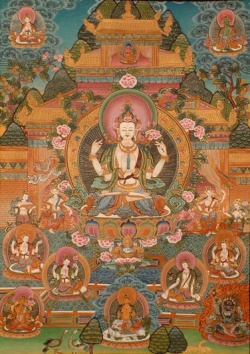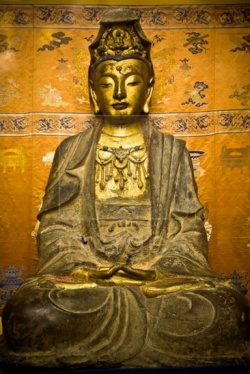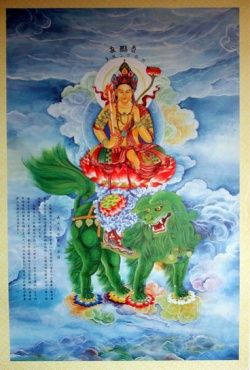The Profound Meaning of Buddhist Ceremonies: Offerings to Monks
Following the article in our July issue, which covered 11 different worship offerings to Dhamma, this month we would like to discuss the different worship offerings to Monks as follows :
Attha Borikhaan (Eight types of personal utensils or belongings) :
There are a total of 8 necessary requisites of the Buddhist monk garments and utensils. These eight items originated with Lord Buddha. He was born a prince in a rich family but preferred a normal life.
jeeworn 1.1 Jeeworn (Mantle Robe) : In the ancient days, the monks collected pieces of cloth from graveyards. These pieces were supposed to cover the dead bodies. Once the dead bodies were cremated, the sheet covers were left over. Choosing the simple life, monks collected those sheet covers and later cleaned them with water. The size was insufficient, in the old days. Several different pieces had to be sewn together in one piece. This large piece was then dyed with some tree root extract or saffron (a common spice in the Himalayan region) to get a brownish-yellow color. As more and more men became followers, Lord Buddha rejected any patched-together "Jeeworn" that lacked neatness. One day he assigned Ananda, his cousin and one of the Buddha's ten great disciples, to create a neat design for the Jeeworn. Ananda looked out at the lowland rice fields in Makoth (Magadha) city and he was impressed by the neatness of chess board-like rice fields. Based on this idea, several pieces of material were cut and sewn into one piece. Once Lord Buddha inspected the whole piece, he deemed it appropriate and approved the design. Whenever a monk leaves his temple or monastery, the Jeeworn must cover the whole body. Meanwhile whenever he is at his temple, he wears the same Jeeworn but leaves the right shoulder uncovered. Any time the Jeeworn is seen now, it reminds us of the colours of the earthen dykes around the rice fields of Makoth city.
sabong 1.2 Sabong ( Sarong) : This is a simple, unadorned sarong of brownish-yellow color. The size of this Sabong is much smaller than the size of the Jeeworn. The Sabong is regarded as the most important garment of Buddhist monks because it must be worn 24 hours a day.
prakod 1.3 Prakod (Cotton Belt or Girdle) : This is not like an ordinary belt but is rather a wide thick brownish-yellow waist band. The main purpose of the Prakod is to secure the Sabong safely.
sangkati 1.4 Sangkati (Shoulder Scarf): It is a long thick brownish-yellow scarf and regarded as a monk's multipurpose cloth. A monk can use this Sangkati as a blanket in winter. During a long trip or visit, this thick Sangkati can be folded and used as a cushion. In general, during a ceremony at the temple, one end of the Sangkati is on the floor and the other end is on the monk's shoulder whenever he bows to the floor in front of the Buddha image.
bart 1.5 Bart (Black Alms Bowl) : This special bowl has a unique shape from a wide, slightly rounded base, its wall slants slightly inward to the top opening. Its cover looks something like a round single-layer, cake-baking pan turned upside down to cover the bowl. With this, Lord Buddha as did the other ascetics of his time collected offerings of food and ate only what he was given. An ascetic was not supposed to have money or any valuables whatsoever.
1.6 Meedgoan (Razor) : Thai Buddhist monks are supposed to shave their heads and eyebrows once a month, one day before the middle of the lunar month, Keun 14 Kaam (Waxing Moon). Mustache and beard must be shaved off, too.
1.7 Khem & Dai (Needle and Thread) : The simple brownish-yellow unadorned Jeeworn, Sabong, Sangkati or Prakod can be patched whenever they are worn or torn. Monks sew with Khem and Dai themselves.
1.8 Grabog Grong-Naam (Water-strainer) : The first of five basic precepts is refraining from killing or hurting animals and human beings. Therefore, drinking water should be freed from dirt and insects by filtering.
Borikhaan Yookmai (Modern-Day Utensils) : Additional Borikhaan utensils are required nowadays for Buddhist monks who stay at their temples whether they are located in the cities, suburbs, up-country, or in isolated areas.
2.1 Garments : The word Pha Trai or Trai Jeeworn is a term for the 3 garments mentioned in 1.1, 1.2, and 1.3, i.e. Jeeworn, Sabong and Sangkati. There are 3 more pieces worn for convenience, (a) Angsa (Vest) is a brownish-yellow undershirt hanging over the left shoulder, but leaving the right shoulder bare. (b) Pha Abnaam (Bathing Robe) is a brownish-yellow loincloth for bathing. (c) Pha Shed Tua (Bath Towel) is an ordinary towel but is brownish-yellow in color.
beddingt 2.2 Bedding Facilities : The natural environment has slowly changed since the years of Lord Buddha. Additional Borikhaan have been considered and added to included luxurious items, i.e. Zua (Grass Mattress), Mawn (Brownish-yellow Pillow), Pha Hom (Brownish-yellow Blanket), Moong (Brownish-yellow Mosquito Nets), Asana (Personal Brownish -yellow Sitting Cushion).
travel gear 2.3 Traveling Necessities : Buddhist monks are supposed to behave properly in public. On the other hand, citizens would not expect Buddhist monks to suffer in a new environment. (a) Pha shed Nah (Brownish-yellow Handkerchief) (b) Yaam (Brownish-yellow Hand Bag), (e) Muag (Knitted Brownish-yellow Slough Hat), (d) Talapaad (Ceremonial Fan made of palm leaves), (e) Rohm (umbrella), (f) Rong Thao(Sandals).
food utensils 2.4 Food Utensils : Buddhist monks are supposed to maintain their health by using proper and hygienic utensils (a) Jaan (Dish), (b) Chaam (Bowl), (c) Chon-Zom (Spoon & Fork), (d) Pha Ched-Mue (Hand Towel), (e) Sum-Rub (A set of Food Trays containing plates and bowls), (f) Pinto (Tiffin Carrier).
2.5 Hygienic Tools : Drinking water must be cleansed of dirt and germs. (a) Tao (Stove), (b) Ga (Water boiling pot), (c) Touy Naam Ron (Hot water Cup), (d) Gaew Naam Yen (Water Glass), (e) Yeug (Water Jug), (f) Paan (Tea Pot), (g) Gratig Naam Khaeng / Gratig Naam Ron / (Thermos for ice cubes or hot water).
2.6 Toiletries : Buddhist monks should be clean and have pleasant personalities. They need some necessary objects, the same as average people (a) Khaan naam (Water Container), (b) Saboo (Soap), (c) Glong Saboo (Soap Container), (d) Praeng See-Fun (Tooth Brush), (e) Ya See Fun (Tooth Paste), (f) Pha Shed Tua (Body Towel), (g) Ga-Daad Shamra (Tissues), (h) Grathon (spittoon), (i) Ya (Medicine Shelf ).
2.7 Residence Utensils : These items should be available to help monks in case of emergency. (a) Kome Fai (Lantern or Lamp), (b) Fai Shye (Flash Light), (e) Nariga Ploog (Alarm Clock).
Asana Sohng or Jong-Saang (Monks' Long Seat) : asana sohng All the monks in any temple are supposed to sit in one long row. The abbot or the most senior monk will sit at the head of the row. All the rest of the monks will sit according to their seniority based on the length of their stay in the monkhood. The last to sit will be the monk or novice who has least seniority. A long seat or chair is built with wood next to the wall of the ceremonial hall. This long Asana Sohng (Sangha) has a width of about 1.20 meters (but the length depends on the number of monks of that temple) and is 70 centimeters above the floor. All monks sit in one row while all male and female Buddhist lay worshippers sit on the floor in the ceremonial hall. Jong is the Thai Yai word meaning residence hall of the monks ( The majority of Thai Yai people live in the Shan state, northwest of northern Thailand). Therefore, the word Jong Sangha means a very long bed which could be installed in a Buddha hall, shrine hall or ceremonial hall, i.e. a multipurpose building. (Monks' Long Seat) : All the monks in any temple are supposed to sit in one long row. The abbot or the most senior monk will sit at the head of the row. All the rest of the monks will sit according to their seniority based on the length of their stay in the monkhood. The last to sit will be the monk or novice who has least seniority. A long seat or chair is built with wood next to the wall of the ceremonial hall. This long Asana Sohng (Sangha) has a width of about 1.20 meters (but the length depends on the number of monks of that temple) and is 70 centimeters above the floor. All monks sit in one row while all male and female Buddhist lay worshippers sit on the floor in the ceremonial hall. Jong is the Thai Yai word meaning residence hall of the monks ( The majority of Thai Yai people live in the Shan state, northwest of northern Thailand). Therefore, the word Jong Sangha means a very long bed which could be installed in a Buddha hall, shrine hall or ceremonial hall, i.e. a multipurpose building.


